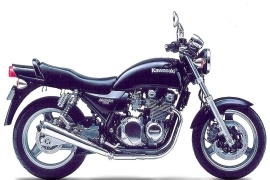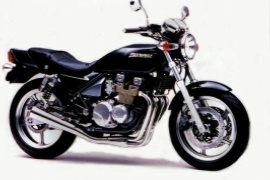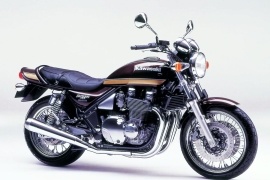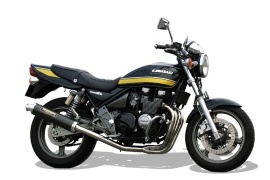KAWASAKI Zephyr Models/Series Timeline, Specifications & Photos
First production year: 1989
The Kawasaki Zephyr was a retro-styled naked motorcycle part of the Zephyr family that comprised three other motorcycles with different engine displacements but similar appearances.
The range comprised four models with different engine capacities, such as 400, 550, 750, and 1,100cc displacements with an air-cooled system. The Kawasaki Zephyr 750 and the 400 and 550cc models had the engine based on the earlier Z400-900 series.
In the aesthetic department, the bike was similar to its siblings, packing standard features, such as a round headlight with instruments mounted on top, a one-piece dual seat with a passenger grab rail, a right side-mounted four-into-one exhaust system, and three-spoke lightweight aluminum wheels.
The 1992 Kawasaki Zephyr 750 had installed underneath its fuel tank a 738cc four-stroke four-cylinder air-cooled engine with four Keihin carburetors in charge, delivering 72 hp at 9,500 rpm and 54 Nm (40 lb-ft) torque at 7,500 rpm.
The bike's engine was tied to a five-speed manual transmission with a wet multi-plate clutch linked to the rear wheel through a final chain drive, pushing the motorcycle to a top speed of 202 kph (126 mph).
In the suspension department, the bike packed a 41 mm telescopic fork on the front with 140 mm wheel travel and dual gas-charged fully adjustable shock absorbers on the rear with 115 mm wheel travel.
The Kawasaki Zephyr was a series of naked superbikes with a retro style manufactured by Kawasaki in the 1990s. The Zephyr was available with four engine capacities, such as 400, 550, 750, and 1,100cc displacements, all with an air-cooled system.
The Kawasaki Zephyr 550 packed the air-cooled engine from the GPZ550 but de-tuned for mid-range power and, with several minor cosmetic modifications, installed in good-looking rolling chassis.
In the visual department, the Zephyr 550 was similar to its siblings, packing standard features, such as a round headlight, a one-piece dual seat, a four-into-one exhaust system with the silencer mounted on the right side, and five-spoke lightweight aluminum wheels.
The bike's suspension system comprised a 39 mm telescopic fork on the front and dual Kayaba preload and rebound-adjustable shock absorbers on the rear, delivering optimum suspension performance and handling.
In the braking department, the bike's wheels were fitted with two 300 mm discs coupled to dual-piston calipers on the front and a 245 mm disc tied to a single-piston caliper on the rear, offering optimum stopping power.
In the performance department, the 1991 Kawasaki Zephyr 550 had installed underneath its fuel tank a 553cc four-stroke four-cylinder liquid-cooled engine fed by four Keihin carburetors, delivering 50 hp at 10,000 rpm and 41 Nm (30 lb-ft) torque at 6000 rpm.
The Kawasaki Zephyr was a range of Retro-styled naked motorcycles made by the Japanese motorcycle manufacturer in the 1990s. The bikes were part of the Z series in Kawasaki's range and were available in four engine configurations, including 400, 550, 750, and 1,100cc displacements.
The Kawasaki Zephyr 1,100 engine was based on the air-cooled DOHC inline-four unit used on the GPZ1100 and Z1000 models and was the only machine featuring two spark plugs per cylinder.
In the visual department, the bike was fitted with standard features, such as a round headlight with the instrument cluster mounted on top, a one-piece dual seat with a passenger grab handle, a four-into-one exhaust system with a muffler on the right side, and five-spoke lightweight aluminum wheels.
The bike was built around a single cradle steel frame with a 43 mm telescopic fork on the front and adjustable side-mounted shock absorbers on the rear, offering optimum suspension performance and handling.
The braking power was handled by two 310 mm discs tied to dual-piston calipers on the front wheel and a 240 mm disc coupled to a two-piston caliper on the rear wheel, providing optimum stopping power.
As for the power figures, the 1991 Kawasaki Zephyr 1100 had its soul brought to life by a 1,062cc four-stroke four-cylinder air-cooled engine that delivered an output power of 93 hp at 8,000 rpm and 89 Nm (66 lb-ft) torque at 7,000 rpm.
The Kawasaki Zephyr was a series of naked superbikes with a naked style made by Kawasaki in the 1990s. The Zephyr was available with four engine displacements, such as 400, 550, 750, and 1,100cc.
The Kawasaki Zephyr was manufactured for the Japanese market in 1989. It was based on the Kawasaki Z1, with dual side-mounted shock absorbers on the rear, an upright riding position, and an air-cooled engine.
In the 1990s, the Kawasaki Zephyr started the naked retro trend boom in the UK and Europe, and for a short period, Kawasaki was in second place among the best-selling motorcycles in the UK market.
In the aesthetic department, the bike was fitted with standard features, such as a round headlight with the instruments mounted on top, a one-piece dual seat, side-mounted rear shocks, a four-into-one exhaust system with a silencer on the right side, and lightweight aluminum wheels.
In the suspension department, the bike packed a telescopic fork on the front and twin side-mounted shock absorbers on the rear, delivering optimum suspension performance and handling.
As for the power figures, the 1989 Kawasaki Zephyr 400 had installed underneath its fuel tank a 399cc four-stroke four-cylinder air-cooled engine fed by four Keihin carburetors, delivering an output power of 46 hp at 11,000 rpm and 30 Nm (22 lb-ft) torque at 10,500 rpm.



